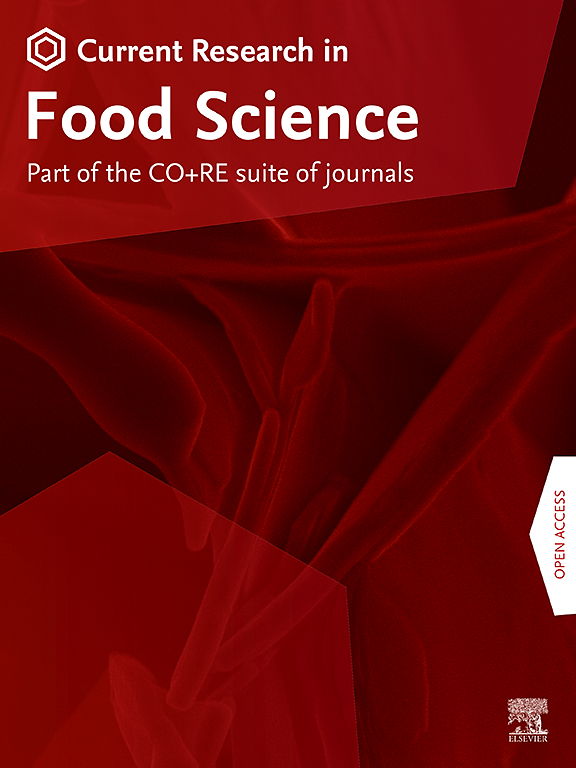Bovine colostrum-derived extracellular vesicles protect against non-alcoholic steatohepatitis by modulating gut microbiota and enhancing gut barrier function
IF 7
2区 农林科学
Q1 FOOD SCIENCE & TECHNOLOGY
引用次数: 0
Abstract
Non-alcoholic steatohepatitis (NASH), characterized by severe fatty liver-associated inflammation and hepatocellular damage, is a major precursor to cirrhosis and hepatocellular carcinoma. While the exact pathogenesis of NASH remains unclear, gut microbiota dysbiosis has been implicated as a key factor contributing to endotoxin translocation and chronic liver inflammation. Recent studies have highlighted the therapeutic potential of bovine colostrum-derived extracellular vesicles (BCEVs) in modulating gut microbiota and enhancing gut barrier function, but their effects on NASH remain largely unexplored. To investigate the potential protective effects of BCEVs against NASH, 8-wk-old mice were fed a NASH-inducing diet for 3 wks while concurrently receiving oral BCEV administration. BCEV treatment markedly ameliorated hepatic steatosis, fibrosis, and inflammation. Transcriptomic analyses demonstrated a notable reduction in lipid metabolism, bacterial response, and inflammatory pathways in the intestine, as well as reduced expression of inflammation- and fibrosis-related pathways in the liver. Gut microbiota profiling revealed an increased abundance of Akkermansia, accompanied by enhanced cholesterol excretion. Furthermore, BCEV treatment promoted the production of tight junction proteins and mucin in the gut, reinforcing intestinal barrier integrity. These findings suggest that BCEVs promote the proliferation of Akkermansia, which in turn prevents endotoxin translocation to the liver. This reduction in endotoxin leakage alleviates hepatic inflammation and fibrosis. Overall, this study highlights the therapeutic potential of BCEVs as a novel strategy for managing NASH by targeting the gut–liver axis through the modulation of gut microbiota and barrier function.

牛初乳来源的细胞外囊泡通过调节肠道微生物群和增强肠道屏障功能来预防非酒精性脂肪性肝炎
非酒精性脂肪性肝炎(NASH)以严重的脂肪肝相关炎症和肝细胞损伤为特征,是肝硬化和肝细胞癌的主要前兆。虽然NASH的确切发病机制尚不清楚,但肠道菌群失调已被认为是导致内毒素易位和慢性肝脏炎症的关键因素。最近的研究强调了牛初乳来源的细胞外囊泡(bcev)在调节肠道微生物群和增强肠道屏障功能方面的治疗潜力,但它们对NASH的影响在很大程度上仍未被探索。为了研究BCEV对NASH的潜在保护作用,研究人员给8周龄小鼠喂食诱导NASH的饮食3周,同时口服BCEV。BCEV治疗可显著改善肝脂肪变性、纤维化和炎症。转录组学分析显示,肠道中的脂质代谢、细菌反应和炎症途径显著减少,肝脏中炎症和纤维化相关途径的表达也显著减少。肠道菌群分析显示Akkermansia的丰度增加,并伴有胆固醇排泄增加。此外,BCEV处理促进了肠道紧密连接蛋白和粘蛋白的产生,增强了肠道屏障的完整性。这些发现表明,bcev促进Akkermansia的增殖,从而阻止内毒素转运到肝脏。内毒素渗漏的减少减轻了肝脏炎症和纤维化。总的来说,这项研究强调了bcev作为一种通过调节肠道微生物群和屏障功能靶向肠-肝轴治疗NASH的新策略的治疗潜力。
本文章由计算机程序翻译,如有差异,请以英文原文为准。
求助全文
约1分钟内获得全文
求助全文
来源期刊

Current Research in Food Science
Agricultural and Biological Sciences-Food Science
CiteScore
7.40
自引率
3.20%
发文量
232
审稿时长
84 days
期刊介绍:
Current Research in Food Science is an international peer-reviewed journal dedicated to advancing the breadth of knowledge in the field of food science. It serves as a platform for publishing original research articles and short communications that encompass a wide array of topics, including food chemistry, physics, microbiology, nutrition, nutraceuticals, process and package engineering, materials science, food sustainability, and food security. By covering these diverse areas, the journal aims to provide a comprehensive source of the latest scientific findings and technological advancements that are shaping the future of the food industry. The journal's scope is designed to address the multidisciplinary nature of food science, reflecting its commitment to promoting innovation and ensuring the safety and quality of the food supply.
 求助内容:
求助内容: 应助结果提醒方式:
应助结果提醒方式:


